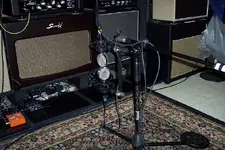JonFro
New member
Hey ya'll just wondering if you have any tips or techniques that I can try?

Since a standard guitar and amp is a mono source (even if there are two speakers), a stereo recording would rely on room reflections to create an image.
miroslav,
A "standard" Blumlein array would be rotated a further 45° (as compared with your photo) so that each mic would face at 45° to the cab? Did you try that as well, or am I just being tricked by the perspective in the photo?
Paul

Since a standard guitar and amp is a mono source (even if there are two speakers), a stereo recording would rely on room reflections to create an image.
A traditional approach for creating a fake stereo image is to double track the guitar and pan them apart. The subtle differences create a sense of width.
A "standard" Blumlein array would be rotated a further 45° (as compared with your photo) so that each mic would face at 45° to the cab? Did you try that as well, or am I just being tricked by the perspective in the photo?
That's what I was thinking. The axis of the Blumlein is at the 45 degree mark between the capsules. Miro's picture looked like MS to me.

Is there anything that *isn't* a mono source?
Most everything we record is mono source.....it's not the source, it's how it's being heard and miked that can make it stereo.
Two ears = stereo
Two mics = stereo when arranged in one of the several stereo configurations.
The reason a mono source becomes a stereo signal is in how its sound reacts within the space, and how our two ears or two mics pick up the direct sound from the source and the various reflections it makes in the space....giving the image a 3D, Left/Right (and to a degree up/down) shape. If it's not dead-center relative to our ears or our two mics....then the Left/Right distances vary, even if slightly...and that is what then really defines the position of the source(s) in the Left/Right image.

Yes. A lot of keyboards and synthesizers are capable of recording in stereo. Or even some electronic drumkits.Is there anything that *isn't* a mono source?
I think "Blumlein Pair" is still maybe a more accurate description because both mics use figure-8 patterns....but an M/S Pair is one mic in figure-8 for Sides and the second in cardioid for Mid....at least that's how I'm making sense of it.
Exactly. Synths usually have L and R output for their stereo patches. Same with guitar processors. But even then, the only reason they're "stereo" is because of the effects, like chorus, delay, etc. Synth drums, too. They'll have a stereo out, but that's because they're taking a bunch of mono sources to combine them into a "stereo drum set".Yes. A lot of keyboards and synthesizers are capable of recording in stereo. Or even some electronic drumkits.
In fact, guitars can be recorded in stereo from a pedal that is capable of producing a stereo signal like a stereo delay.
Well, unless I am mistaken, Alan Blumlein also developed the M/S technique so there is no error in attaching his name to the technique.
